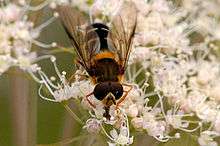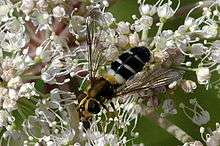Leucozona glaucia
Leucozona glaucia is a Palearctic hoverfly. Larvae feed on ground layer aphids. Adults are usually seen visiting flowers.[1][2][3]
| Leucozona glaucia | |
|---|---|
 | |
| male | |
 | |
| female | |
| Scientific classification | |
| Kingdom: | |
| Phylum: | |
| Class: | |
| Order: | |
| Family: | |
| Genus: | |
| Subgenus: | Ischyrosyrphus |
| Species: | L. glaucia |
| Binomial name | |
| Leucozona glaucia | |
| Synonyms | |
Description
External images
For terms see Morphology of Diptera
Wing length 8-11·25 mm. Scutellum yellow. Tergite 2 has large silverish-white to yellowish- white marks (often merged). Tergites 3 and 4 have narrow or absent markings.
The male genitalia are figured by Dusek and Laska (1967) .[4] The larva is figured by (Dusek and Laska (1962) [5]
See references for determination
[6]
[7]
[8][9]
Distribution
Palearctic from Fennoscandia South to the Pyrenees.Ireland East through Central Europe into Turkey and European Russia, Russian Far East and Siberia and the Pacific coast (Kuril Islands and Japan). [10][11]
Biology
Habitat: Quercus and Fagus forest, riverine gallery forest of Fraxinus and Salix, beside streams, in clearings, along tracks.[12] Flowers visited include white umbellifers, Filipendula, Sambucus, Senecio.[13] The flight period is May to September, with the peak in July and August. The larvae feed on aphids.
References
- Ball, S.G.; Morris, R.K.A. (2000). Provisional atlas of British hoverflies (Diptera, Syrphidae). Monks Wood, UK: Biological Record Centre. pp. 167 pages. ISBN 1-870393-54-6.
- Morris, Roger, K. A. (1999). Hoverflies of Surrey. Surrey Wildlife Trust. p. 244. ISBN 0-9526065-3-4.CS1 maint: multiple names: authors list (link)
- Stubbs, Alan E.; Falk, Steven J. (1983). British Hoverflies: An Illustrated Identification Guide. British Entomological & Natural History Society. p. 253, xvpp.
- Dusek, J. & Laska, P. (1967) Versuch zum aufbau eines Naturlichen Systems mitteleuropaischer Arten der Unterfamilie Syrphinae (Diptera). Acta sc. nat. Brno, 1: 349-390.
- Dusek, J. & Laska, P. (1962) Beitrag zur Kenntnis einiger Syrphiden-larven (Diptera, Syrphidae). Acta Soc. Ent. Cechosloveniae, 59: 348-356.
- Van Veen, M. (2004) Hoverflies of Northwest Europe: identification keys to the Syrphidae. 256pp. KNNV Publishing, Utrecht.addendum
- Van der Goot,V.S. (1981) De zweefvliegen van Noordwest - Europa en Europees Rusland, in het bijzonder van de Benelux. KNNV, Uitgave no.32: 275pp. Amsterdam.
- Bei-Bienko, G.Y. & Steyskal, G.C. (1988) Keys to the Insects of the European Part of the USSR, Volume V: Diptera and Siphonaptera, Part I. Amerind Publishing Co., New Delhi. ISBN 81-205-0080-6.
- Coe, R.L. (1953) Diptera: Syrphidae. Handbks.ident.Br.insects, 10(1): 1-98. R.ent.Soc.London. pdf
- Fauna Europaea
- Peck, L.V. (1988) Syrphidae. In: Soos, A. & Papp, L. (eds.) Catalogue of Palaearctic Diptera, 8: 11-230. Akad.Kiado, Budapest.
- Speight, M.C.D. (2011). "Species accounts of European Syrphidae (Diptera)" (PDF). Syrph the Net, the database of European Syrphidae. 65: 285pp.
- de Buck, N. (1990) Bloembezoek en bestuivingsecologie van Zweefvliegen (Diptera, Syrphidae) in het bijzonder voor België. Doc.Trav. IRSNB, no.60, 1-167.